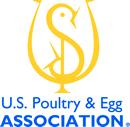US Poultry & Egg Association announces research results

US Poultry & Egg Association has announced the completion of three research projects. They are part of the Association’s comprehensive research program encompassing all phases of poultry and egg production and processing.
Brief summaries of the three projects are shown below:
“Evaluation of Surface-Applied Char and Activated Carbon on the Reduction of Ammonia Volatilization from Broiler Litter” by Ritz
Ammonia can have adverse effects on live poultry production by affecting bird growth and increasing the risk of disease. Historically, ventilation has been used to reduce concentrations. Additionally, when ammonia, dust, and odors are expelled from poultry houses they may create conditions that impact neighbors. The purpose of this research was to evaluate the use of peanut hull char (peanut hulls heated to 752 F) and active carbon chars (two acidified chars) as surface application to broiler litter. Addition of peanut hull char did not reduce ammonia concentrations in the air compared to untreated pine shavings. However, the addition of acidified chars (53% sulfuric acid: pH 2.0 made from pine chips and coconut husks) reduced the overall ammonia release compared to controls, which was likely due to a pH reduction of litter. Bird performance was not adversely affected by char treatments.
“Microbiological Comparisons of Table Eggs Harvested from Cage Laying Hens and Cage-Free Floor Reared Laying Hens” by Buhr et.al.
Animal welfare concerns have caused some food venders to require table eggs be produced by hens maintained on floor environments instead of in cages. There is limited information on the microbiology of eggs from hens housed under these opposing laying conditions. Research was conducted to compare the microbiology of eggs obtained from white and brown layer strain hens (22-52 weeks) housed in conventional cages (CC), wire slats (WS), and floor shavings (FS) treatments. Non-washed eggs from the floor treatment had significantly higher aerobic bacteria numbers (APC) than eggs from cage and wire slat treatments. Washing eggs significantly reduced APC levels and resulted in similar APC levels for the three treatments. Moving hens from CC, WS, and FS treatments to 2-hen triple-deck battery cage units (with manure removal belts) at 52 weeks of age resulted in lower and similar APC levels in all three treatments. Returning hens at 56 weeks of age to their original housing treatments (CC, WS, and FS) resulted in non-washed eggs having similar APC levels to those observed from 22-52 weeks. In addition to higher aerobic bacteria levels, the potential for horizontal transmission of Salmonella and Campylobacter was found to be greater among hens housed on floor shavings.
“Animal Welfare Aspects of Poultry Slaughter” by Fletcher at. al.
Stunning is a welfare issue relative to humane slaughter of poultry. Current information is limited and little objective data exist. A primary concern is whether electrical stunning completely renders the animal unconscious and insensible to pain prior to death. An animal behavior model and EEG&##39;s were used to evaluate the impact of stunning on the birds memory responses to electrical stimulus. Birds were either untreated (control), shocked, stunned, or delayed stunned to observe their behavior in repeated trials. Although highly variable, all electrical treatments resulted in an increased delay in approaching the reward and distinct behavioral differences from controls. The EEG results showed differences both prior to and following electrical treatments. Electrical stunning resulted in some level of learned response and therefore cannot be considered to be totally benign. Although inconclusive, the results of this research indicate that birds electrically stunned and allowed to recover develop some behavioral response compared to controls.
Complete reports, along with information on other Association research, can be found at www.poultryegg.org.












